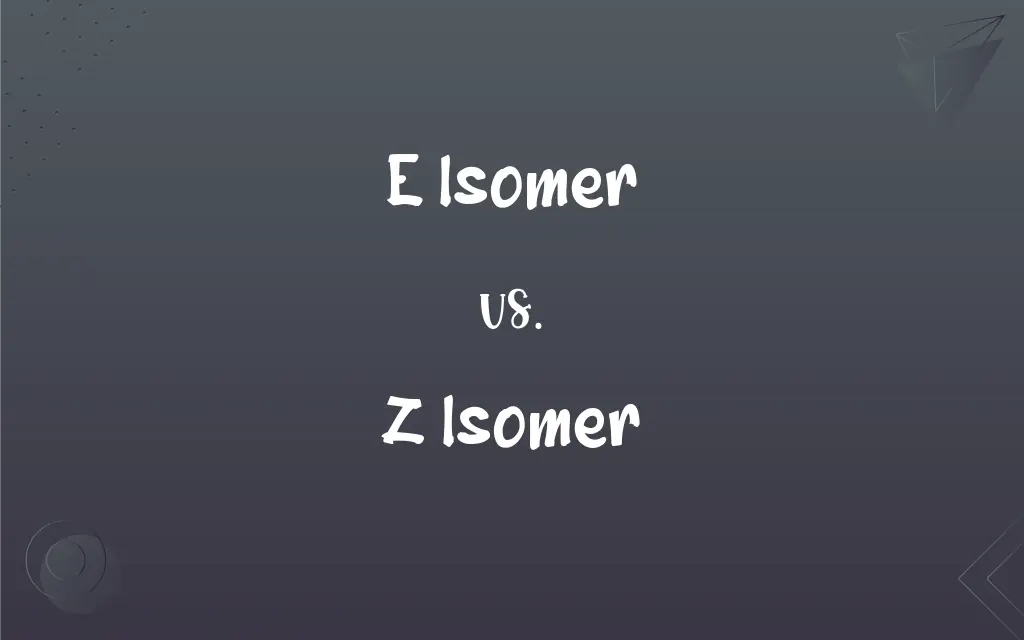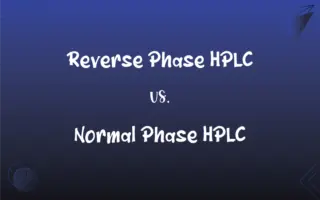E Isomer vs. Z Isomer: What's the Difference?
Edited by Aimie Carlson || By Janet White || Published on February 28, 2024
E isomers have the highest priority groups on opposite sides of a double bond, while Z isomers have them on the same side, in the context of geometric isomerism in chemistry.

Key Differences
E isomers (from the German 'Entgegen') feature the highest priority substituents on opposite sides of a carbon-carbon double bond. Z isomers (from the German 'Zusammen') have the highest priority substituents on the same side of a double bond.
The designation of E and Z is based on the Cahn-Ingold-Prelog priority rules, where the groups attached to the double-bonded carbons are ranked according to atomic number. In E isomers, the highest priority groups are diagonally opposite, while in Z isomers, they are adjacent.
E isomers often have a different shape and physical properties compared to Z isomers due to the spatial arrangement of the substituents. Z isomers, with priority groups on the same side, can exhibit different reactivity and interactions based on their spatial configuration.
In biochemical contexts, E and Z isomerism can significantly affect the function and interaction of molecules, such as in vision where retinal exists in different isomeric forms. The E/Z configuration can influence molecular geometry, affecting biological activity and properties.
The determination of E or Z isomers is essential in organic chemistry, especially in the synthesis and study of complex molecules, as the isomerism can drastically change a compound's characteristics and reactivity.
ADVERTISEMENT
Comparison Chart
Position of Substituents
On opposite sides of the double bond.
On the same side of the double bond.
Priority Rule Application
Highest priority groups are diagonal.
Highest priority groups are adjacent.
Physical Properties
Differ due to spatial arrangement.
Differ based on group proximity.
Chemical Reactivity
Reactivity varies with structure.
Unique reactivity due to configuration.
Biological Significance
Can influence molecular function differently.
Plays a role in molecular interactions.
ADVERTISEMENT
E Isomer and Z Isomer Definitions
E Isomer
Characterized by diagonal arrangement of substituents.
In the E isomer, the bulky groups are positioned diagonally, affecting its reactivity.
Z Isomer
Can have distinct reactivity and interactions.
The Z isomer showed different enzymatic reactivity compared to its E counterpart.
E Isomer
Isomer with opposite sides priority groups on a double bond.
The E isomer of the compound showed less solubility due to its structure.
Z Isomer
Characterized by adjacent placement of high-priority groups.
In the Z isomer, the similar groups were adjacent, impacting its stereochemistry.
E Isomer
Often leads to a different molecular shape.
The E isomer's shape affected its ability to fit into the enzyme's active site.
Z Isomer
Isomer with same side priority groups on a double bond.
The Z isomer exhibited higher polarity due to its substituent arrangement.
E Isomer
Determined by Cahn-Ingold-Prelog priority rules.
According to priority rules, this molecule was identified as an E isomer.
Z Isomer
Identified by Cahn-Ingold-Prelog rules in stereochemistry.
The molecule was classified as a Z isomer based on the priority of its attached groups.
E Isomer
Influences physical and chemical properties of molecules.
The boiling point of the compound varied significantly in its E isomer form.
Z Isomer
Influences molecular geometry and biological activity.
In biological systems, the Z isomer of the molecule played a different role.
FAQs
Can E and Z isomers interconvert?
Not without breaking the double bond.
What is an E isomer?
A geometric isomer with high-priority groups on opposite sides of a double bond.
Do E and Z isomers have different physical properties?
Yes, due to their different spatial arrangements.
Can the E/Z isomerism affect drug activity?
Yes, it can significantly influence the efficacy and interactions of drugs.
How is a Z isomer defined?
An isomer with high-priority groups on the same side of a double bond.
How does the E/Z configuration affect a molecule's reactivity?
It changes the molecule's shape and can alter reactivity and interactions.
What dictates the E or Z classification?
The Cahn-Ingold-Prelog priority rules based on atomic numbers.
Are there any health implications of E/Z isomers?
In biological systems, different isomers can have different effects.
How are E and Z isomers identified in a lab?
Through spectroscopic techniques and chemical analysis.
How does E/Z isomerism occur naturally?
It can occur in biological processes and in natural compounds.
Can light or heat cause E/Z interconversion?
Only if they provide enough energy to break the double bond.
Are E isomers always less soluble than Z isomers?
Not always, but their solubility can vary based on structure.
Is the E or Z configuration more stable?
It depends on the specific molecule and its substituents.
Do all double bonds show E/Z isomerism?
Only those with different substituents around the double bond.
Are E and Z isomers a type of stereoisomer?
Yes, they are types of geometric (cis-trans) stereoisomers.
Can E/Z isomerism be controlled in chemical synthesis?
Yes, through specific reaction conditions and catalysts.
Are E and Z isomers easy to distinguish?
Yes, through methods like NMR spectroscopy or X-ray crystallography.
Is the E isomer more common than the Z isomer?
Their occurrence depends on the specific chemical context.
Can E/Z isomerism be predicted computationally?
Yes, with molecular modeling software.
Does E/Z isomerism affect boiling and melting points?
Yes, it can influence these physical properties.
About Author
Written by
Janet WhiteJanet White has been an esteemed writer and blogger for Difference Wiki. Holding a Master's degree in Science and Medical Journalism from the prestigious Boston University, she has consistently demonstrated her expertise and passion for her field. When she's not immersed in her work, Janet relishes her time exercising, delving into a good book, and cherishing moments with friends and family.
Edited by
Aimie CarlsonAimie Carlson, holding a master's degree in English literature, is a fervent English language enthusiast. She lends her writing talents to Difference Wiki, a prominent website that specializes in comparisons, offering readers insightful analyses that both captivate and inform.
































































